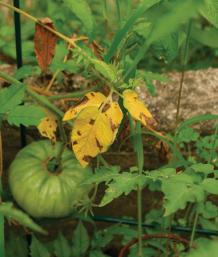
Photo/Illustration: Steve Aitken
Northeastern gardeners have not quite recovered from the late-blight outbreak of 2009. To help prevent future outbreaks, prime yourself with some know-how.
Late blight is a plant disease that mainly attacks potatoes and tomatoes. It is caused by an oomycete pathogen that infects a plant, causing it to develop a fungus, which in turn produces millions of fungal spores. These spores travel through the air, land on other plants, and—if the weather is sufficiently wet—cause new infections.
Dark brown–purple lesions appear on the leaves and stems of infected plants; the leaves may also turn yellow. On tomato fruit, late blight causes dark, firm, greasy-looking lesions.
Infected potatoes have rotten brown spots on the surface of the tuber. Once a plant is infected, the fruit or tuber will quickly rot. It is important to destroy—not compost—all infected plants. Some farmers recommend burning the plants and fruit/tubers of late-blight victims.
How to prevent it
Fine Gardening Recommended Products

Pruning Simplified: A Step-by-Step Guide to 50 Popular Trees and Shrubs
Fine Gardening receives a commission for items purchased through links on this site, including Amazon Associates and other affiliate advertising programs.

Corona AG 4930 Long Straight Snip, Tempered Steel
Fine Gardening receives a commission for items purchased through links on this site, including Amazon Associates and other affiliate advertising programs.

3 Pack 4.1Inch Bonsai Pruning Scissors
Fine Gardening receives a commission for items purchased through links on this site, including Amazon Associates and other affiliate advertising programs.



















Comments
Log in or create an account to post a comment.
Sign up Log in